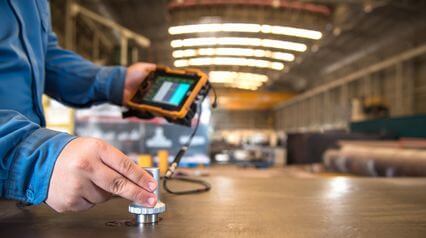Welding is vital in various industries, including construction, manufacturing, and automotive. However, welding can also pose safety hazards if not done correctly. Therefore, it is crucial to ensure that welding meets the highest standards and safety measures. The nondestructive testing inspector is essential for welding inspection, ensuring that welded joints are safe and reliable. This article discusses the importance of non destructive testing inspector and its various techniques.
What is Nondestructive Testing (NDT)?
Nondestructive testing (NDT) inspects, tests, and evaluates materials or components without damaging or destroying them. NDT is essential to quality control and safety in the welding, manufacturing, and construction industries. NDT techniques can identify defects, such as cracks, porosity, inclusions, and other imperfections, that could compromise the integrity and safety of the welded joint.
NDT techniques include visual testing, radiography, ultrasonic testing, magnetic particle testing, liquid penetrant testing, and eddy current testing. Each technique has its advantages and limitations, depending on the type of material, the size of the welded joint and the level of accuracy required.
Importance of NDT in Welding Inspection
Welding defects can compromise welded joints’ structural integrity and safety, leading to catastrophic failures. A nondestructive testing inspector is crucial for detecting welding defects that may not be visible to the naked eye. NDT can also evaluate welded joints’ internal structure and properties, providing information on their strength, flexibility, and toughness.
NDT is an essential tool for welding inspection in the manufacturing industry, where quality control is critical for ensuring the safety and reliability of products. NDT can detect surface and subsurface defects in welded joints, preventing costly rework and ensuring compliance with industry standards and regulations.
NDT is also essential in the construction industry, where welded joints are critical components of buildings, bridges, and other infrastructure. NDT can detect defects in welded joints that may compromise the safety and durability of the structure, preventing catastrophic failures and ensuring public safety.
NDT Techniques for Welding Inspection
Visual Testing:
Visual testing is the simplest NDT technique for welding inspection and the least reliable. Visual testing can detect surface defects, such as cracks, undercut, and porosity, but cannot detect subsurface defects. Visual testing is often a preliminary inspection before more advanced NDT techniques.
Radiography:
Radiography is a technique that uses X-rays or gamma rays to inspect welded joints. Radiography can detect surface and subsurface defects, such as cracks, porosity, inclusions, and lack of fusion. Radiography provides a permanent record of the weld, making it a useful tool for quality control and documentation.
Ultrasonic Testing:
Ultrasonic testing (UT) is a technique that uses high-frequency sound waves to inspect welded joints. UT can detect surface and subsurface defects, such as cracks, porosity, and inclusions. UT can also evaluate the thickness and internal structure of welded joints. UT is a reliable and accurate NDT technique but requires skilled operators and specialized equipment.
Magnetic Particle Testing:
Magnetic particle testing (MT) is a technique that uses magnetic fields and iron particles to inspect welded joints. MT can detect surface and near-surface defects, such as cracks and lack of fusion. MT is a fast and economical NDT technique with a limited detection depth.
Liquid Penetrant Testing:
Liquid penetrant testing (PT) is a technique that uses a dye or fluorescent liquid to detect surface defects in welded joints. PT is a simple and cost-effective NDT technique but can only detect surface defects.
Eddy Current Testing:
Eddy current testing (ECT) is a technique that uses electromagnetic induction to inspect welded joints. ECT can detect surface and subsurface defects, such as cracks, corrosion, and wall thinning. ECT is a non-contact NDT technique that can evaluate welded joints’ electrical conductivity and magnetic permeability.
Conclusion:
In conclusion, nondestructive testing (NDT) is essential for welding inspection, ensuring that welded joints are safe and reliable. Nondestructive testing inspector techniques can detect defects that may not be visible to the naked eye, evaluate the internal structure and properties of welded joints, and provide a permanent record of the weld.
NDT is crucial in industries such as manufacturing and construction, where quality control and safety are critical. NDT techniques include visual testing, radiography, ultrasonic testing, magnetic particle testing, liquid penetrant testing, and eddy current testing, each with advantages and limitations.
Therefore, it is crucial to use the appropriate NDT technique for a specific application to ensure the safety and reliability of welded joints.
Also Read:
Selecting the Best Home Inspector













